
Malaysian lunch fare dazzles with a symphony of flavours of fragrant spices, rich coconut milk and zingy herbs. With roots in Malay, Chinese and Indian cuisines, each dish delights in its own unique way. From comforting bowls of curry laksa to smoky satay fresh off-the-grill, a Malaysian lunch is truly an unforgettable experience.
So grab a fork or better yet, dive in with your fingers and join us as we explore the vibrant world of Malaysian mid-day meals. Warning: side effects may include sudden cravings and an insatiable desire to book a flight to test these out yourself. Let's dig in, shall we?
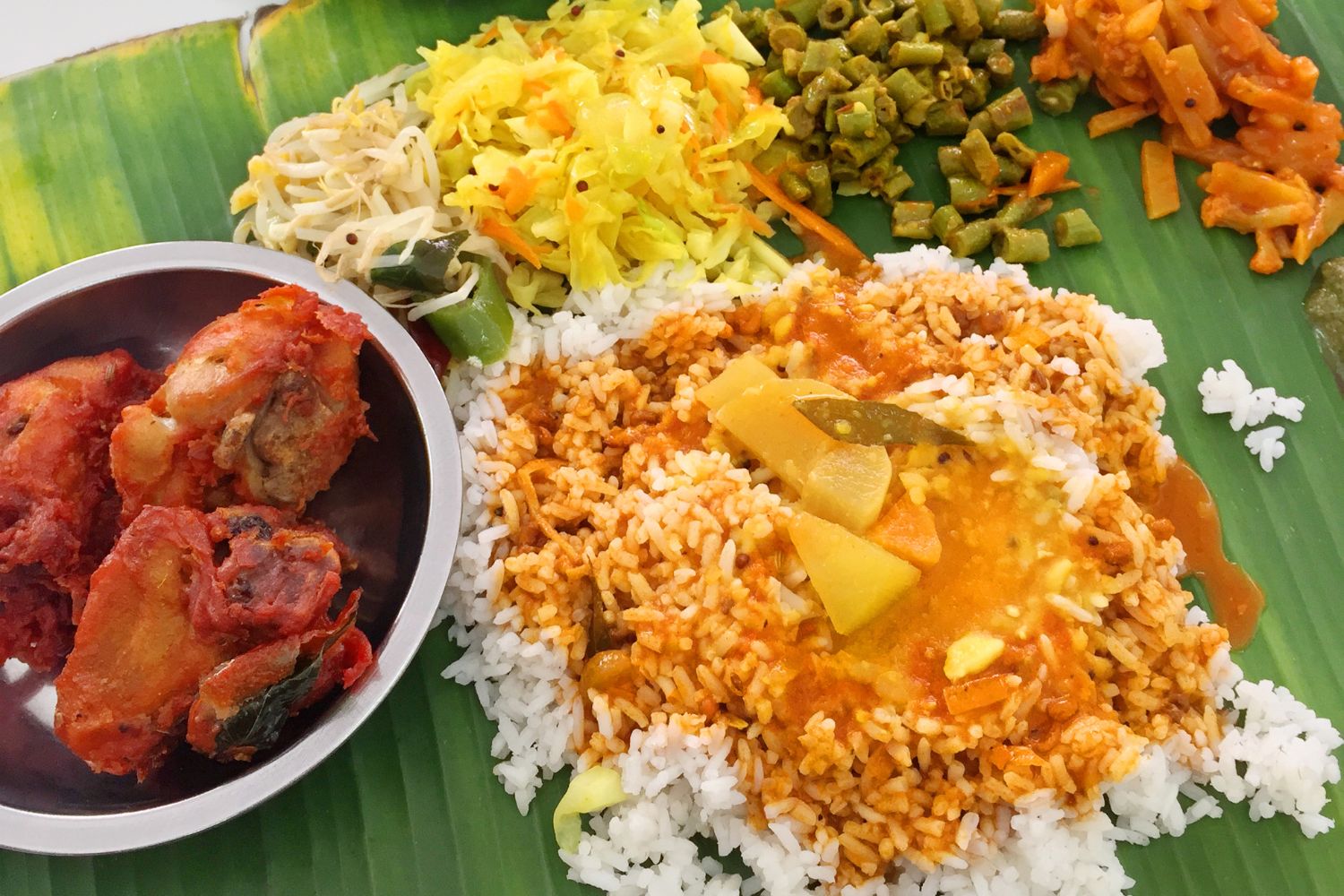
Banana Leaf Rice is a quintessential Malaysian cuisine, deeply rooted in the nation's cultural heritage. Served on a fresh sheet of banana leaf, its eco-friendly presentation naturally adds a subtle aroma whilst enhancing the flavours of the meal.
This dish features a generous serving of white rice, accompanied by a variety of curries, vegetables and condiments to create a symphony of tastes that tantalise the senses. For those who prefer other alternatives to white rice, this meal can also be enjoyed with a variety of flatbreads such as roti canai, thosai or chapati.
Banana Leaf Rice is more than just Malaysian soul food; it also symbolises the unity and harmony of the country’s diverse cultural tapestry. As Malaysians continue to embrace their multicultural identity, Banana Leaf Rice remains an integral part of the country’s staple, whether it is being enjoyed over casual meals or as a festive treat across various celebrations, reflecting the enduring legacy of shared traditions and communal bonds.
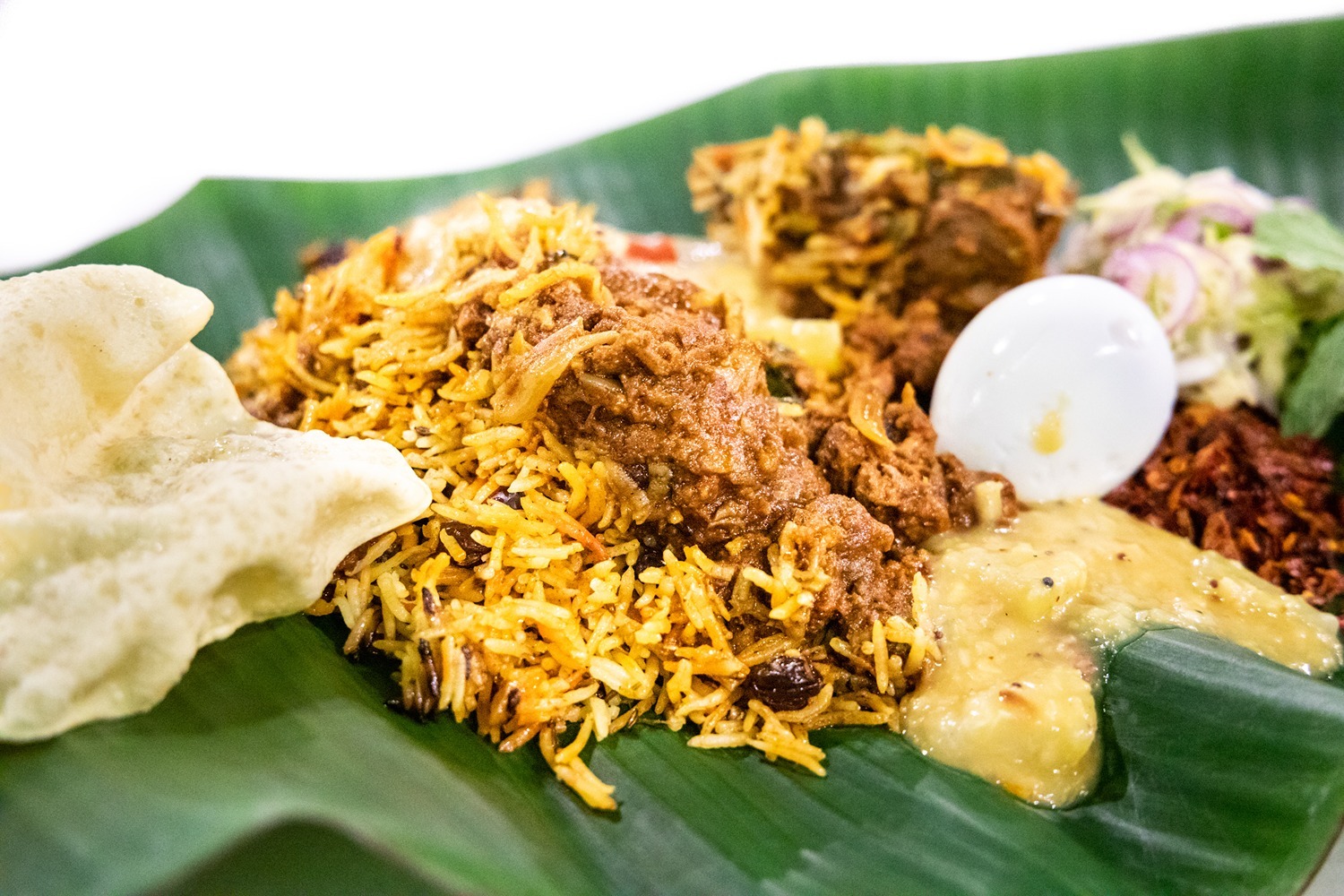
Nasi Briyani is a fragrant rice dish that is a specialty of the Indian community in Malaysia. It is made with long-grain basmati rice flavoured with a heady blend of spices, including saffron, cardamom, cinnamon and star anise, along cooked with tender chunks of meat or vegetables.
The most common types of nasi briyani in Malaysia are chicken and mutton, but vegetarian versions made with mixed vegetables or paneer (Indian cottage cheese) are also popular. The meat or vegetables are marinated in a spicy yoghurt-based sauce before being layered with the rice and cooked together until the flavours meld and the rice is fluffy and aromatic.
Nasi briyani is often served with a variety of accompaniments, including dhal (lentil curry), acar (pickled vegetables) and a cooling raita (yoghurt sauce) to balance out the heat of the spices. It is a hearty, satisfying meal that's perfect for lunch or dinner. Nasi Briyani is also a halal meal that is able to be enjoyed by everyone.
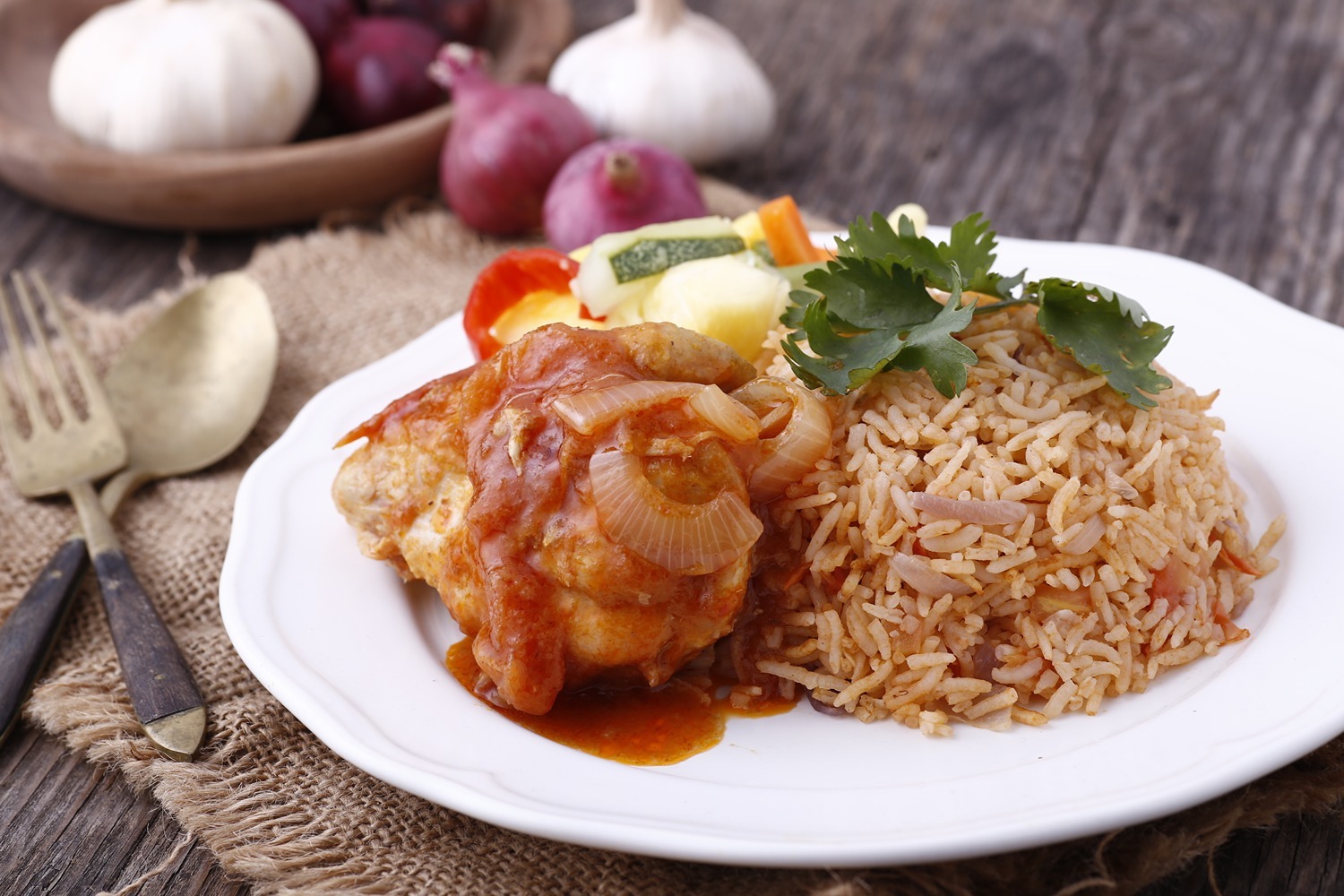
Nasi Tomato, which means ‘tomato rice’ in Malay, is a fragrant rice dish that is popular in the northern states of Malaysia, particularly Kedah and Penang. It is made with long-grain rice that is cooked in a tomato-based sauce flavoured with spices like cinnamon, cloves and star anise, giving it a beautiful reddish hue and a subtle sweetness.
Nasi tomato is served with different accompaniments, such as ayam masak merah (chicken in spicy tomato sauce), sambal sotong (squid in spicy chillies sauce) and boiled eggs. Some hawkers also serve it with a side of acar (pickled vegetables) or keropok (shrimp crackers) for added crunch plus texture.
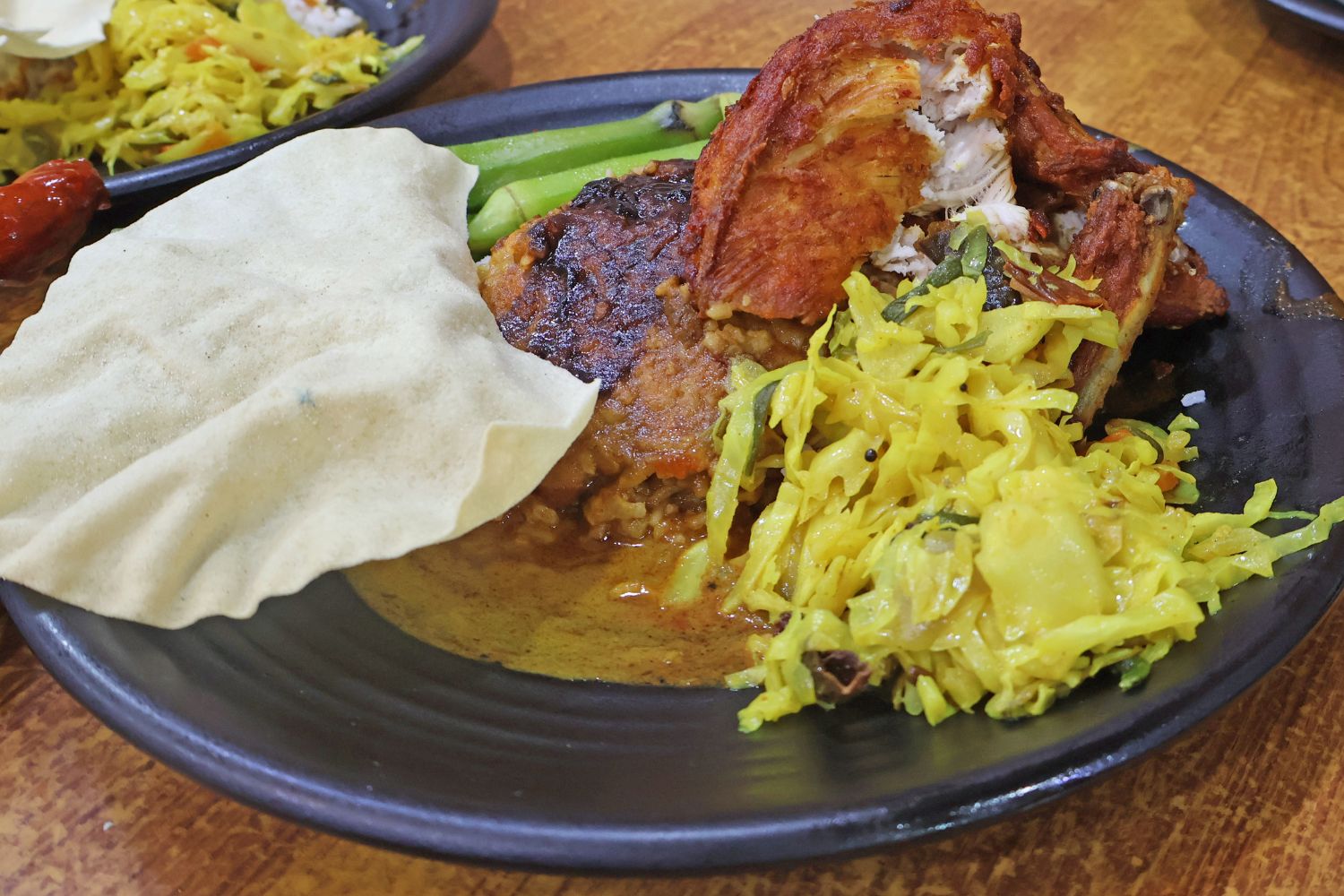
Few dishes embody Malaysian multiculturalism quite like Nasi Kandar. Born in Penang, this Indian Muslim rice dish refers to the kandar pole that vendors traditionally used to transport their wares.
The basics of this dish include steamed white rice accompanied by a smorgasbord of curries, stir-fries, vegetables and sides. Must-orders include ayam goreng (fried chicken), kari ikan (fish curry), sotong (squid), okra, eggplant and a hard-boiled egg.
The pièce de résistance is a scoop of kuah campur - a heavenly mishmash of all the different curry gravies poured over your mountain of rice.
At a nasi kandar shop, your plate is a blank canvas. Load it up with as many items that will fit, then watch in glee as the server ladles curry over the top with wild abandon. Dining options run the gamut from humble hawker stalls to 24-hour air-conditioned restaurants with extensive menus.
A word of warning: nasi kandar is not for the faint of heart (or those watching their waistlines). A typical plate can easily clock in at over 1,000 calories. But therein lies the appeal - it is a deeply satisfying feast that will leave you in a blissful food coma. Just make sure to wear loose pants and prepare for an afternoon nap afterwards.
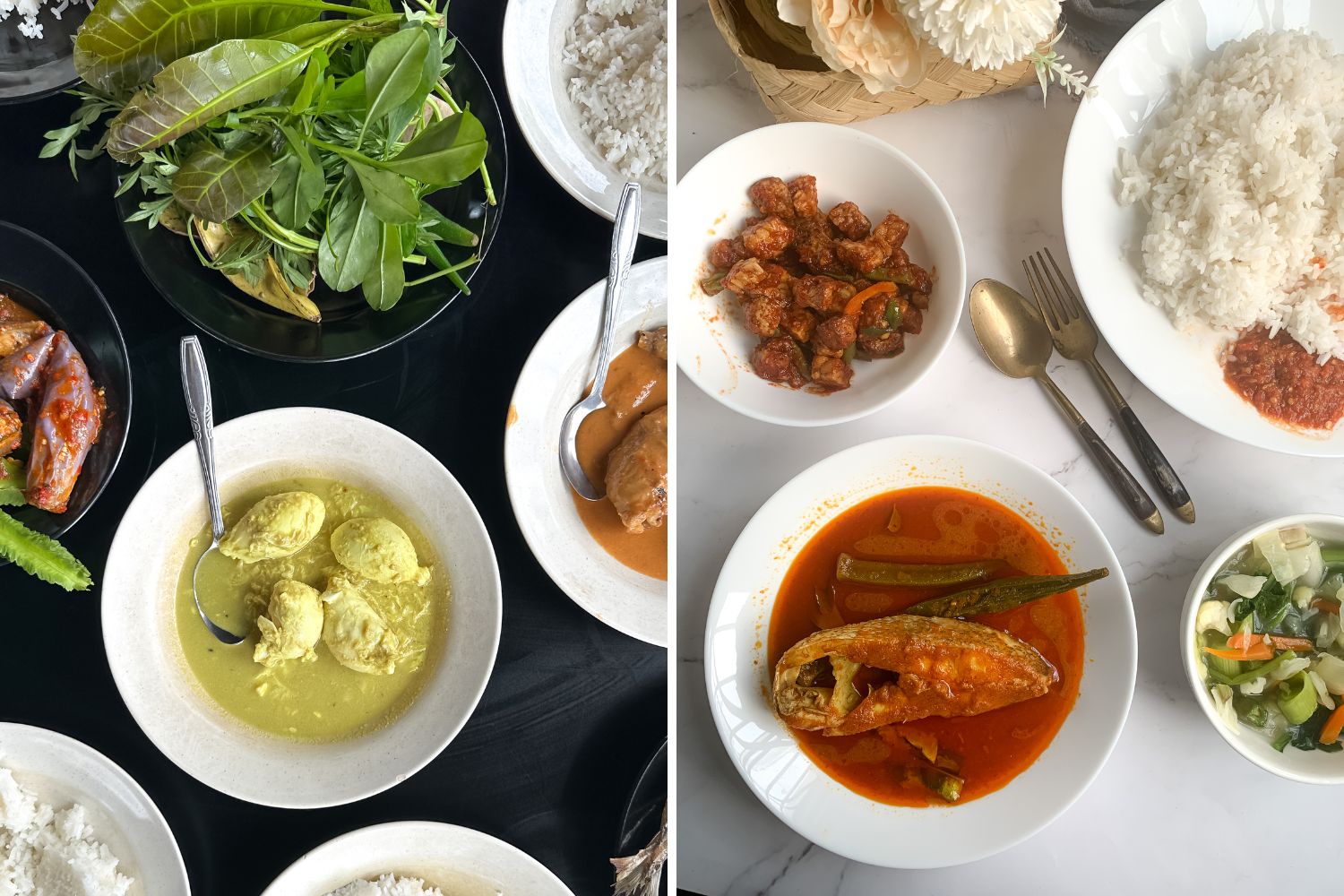
Nasi Campur, which literally means ‘mixed rice’ in Malay, is a beloved lunchtime staple that showcases the incredible diversity and flavour of Malaysian cuisine. It is essentially a smorgasbord of dishes – from curries to stir-fries to salads along with sambals – served atop a bed of steamed rice.
The exact composition of nasi campur varies widely depending on the region and the hawker, but some common elements include ayam goreng (fried chicken), rendang (slow-cooked beef curry), sambal sotong (squid in spicy chillies sauce), sayur lodeh (vegetable curry) and acar (pickled vegetables). Diners can mix and match their favourite dishes to create a personalised meal that is bursting with flavour and variety.
The side dishes for different ethnic backgrounds are typically comprised as such:
Chinese:
Indian:
Malay:
Nasi Campur is a popular choice for busy office workers and students who want a quick yet satisfying lunch. It is also a great way for tourists to sample a wide range of Malaysian dishes in one sitting.
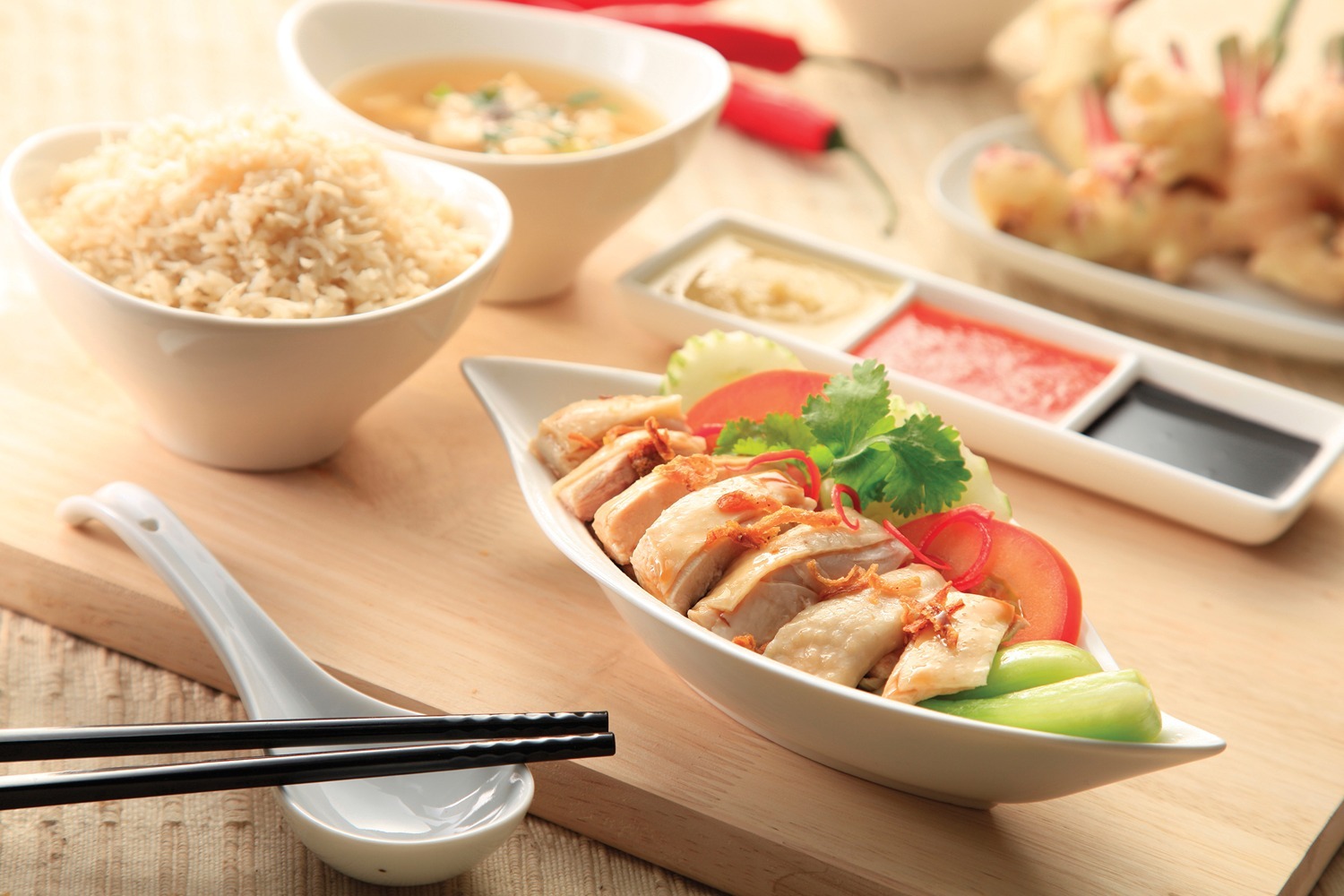
Nasi Ayam, which means ‘chicken rice’ in Malay, is a simple yet beloved dish that is a staple across Malaysian hawker centres and coffee shops. It consists of tenderly poached chicken served atop a bed of fragrant rice that has been cooked in chicken broth and flavoured with ginger, garlic and pandan leaves.
The key to a great nasi ayam is the quality of the chicken, which should ideally be juicy, tender and infused with the delicate flavours of the poaching liquid. Some hawkers use kampung (free-range) chicken for a more robust flavour, while others opt for the milder taste of farmed chicken. Most hawkers will offer the option of serving the chicken steamed, roasted or fried.
Nasi ayam is typically served with a trio of sauces: a spicy chilli sauce, a sweet soy sauce and a pungent ginger sauce. These sauces allow diners to customise the flavour of their meal to suit their own tastes and preferences.
While nasi ayam is most commonly associated with the Chinese community in Malaysia, it has become a beloved national dish that is enjoyed by people of all backgrounds. It is a simple, comforting meal that is perfect for a quick lunch or a lazy weekend brunch.
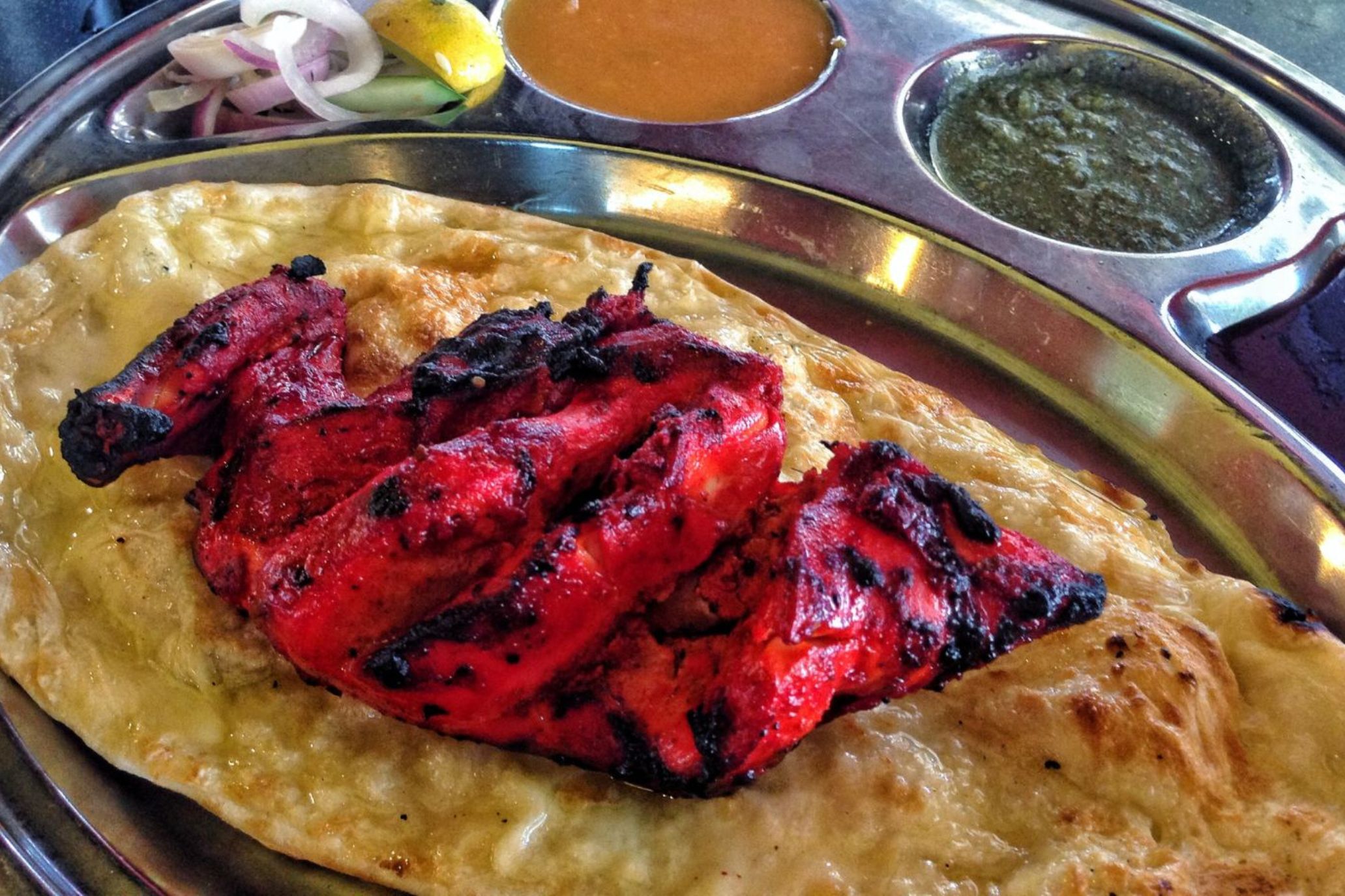
Another popular Indian lunch devoured by many Malaysians is Naan. Yet another version of Indian bread, naan is a thicker and fluffier flatbread. What makes this teardrop-shaped bread unique is that it is traditionally baked in a tandoor oven, which is an oval-shaped clay oven that can be enjoyed with many toppings such as garlic, cheese also butter.
A dish that is best eaten with naan is none other than the tandoori chicken. Cooked to perfection in the same tandoori oven, tandoori chicken is slathered in an array of Indian spices that infuse the meat with a burst of flavour. Both the naan and tandoori chicken are halal food options which are commonly served in Indian food outlets across Malaysia.
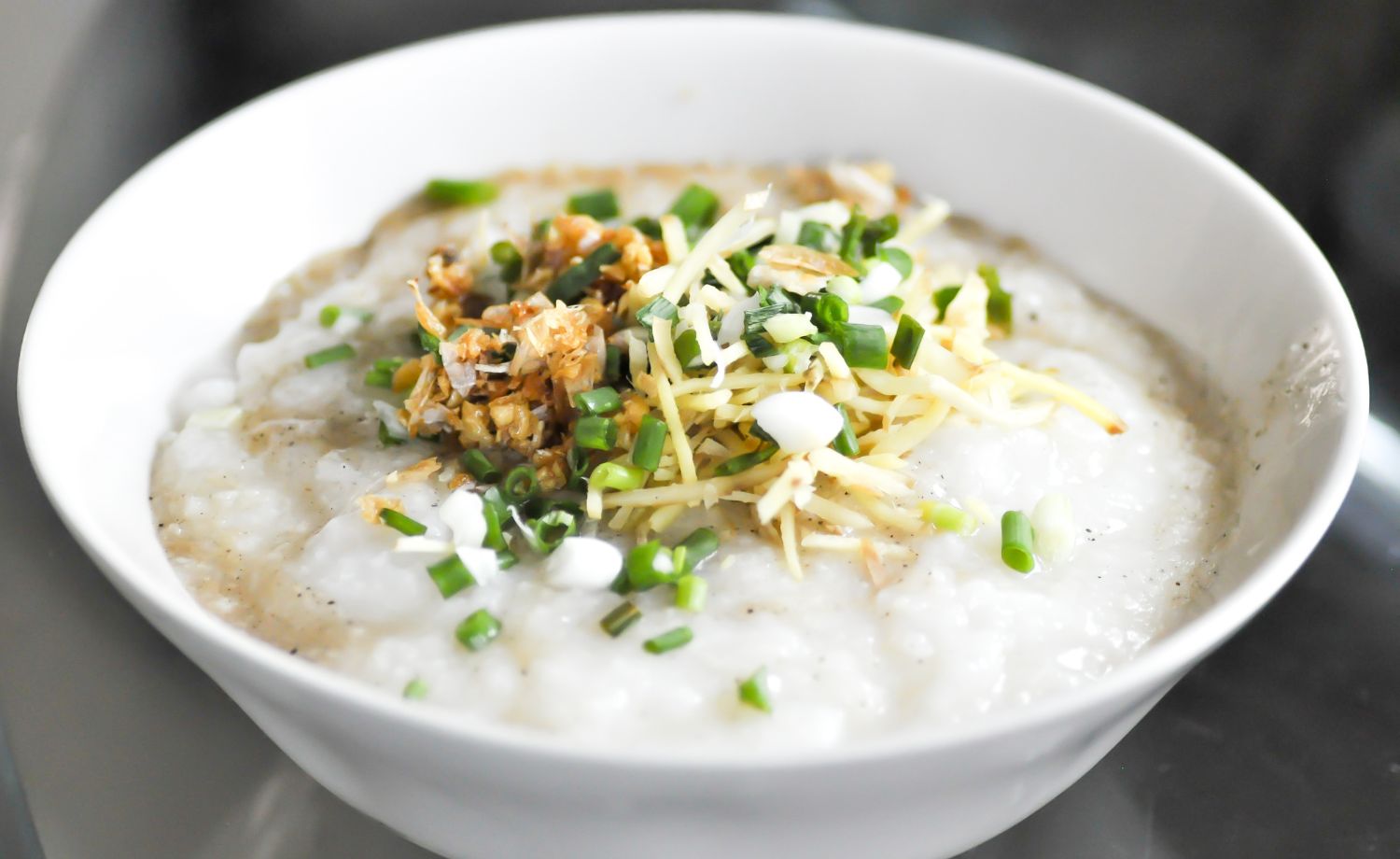
If you are looking for a hearty lunch, look no further than a warm bowl of Teochew Porridge for the most comforting meal. This meal features plain white rice porridge that is served alongside a colourful variety of side dishes including vegetables, minced meat or seafood, century eggs and many more.
This is often a go-to lunch, especially for the Chinese, as it is fast to serve plus keeps you satisfied throughout the day. However, most Teochew Porridge is non-Halal and will commonly be found in Chinese Hawker stall-like shops.
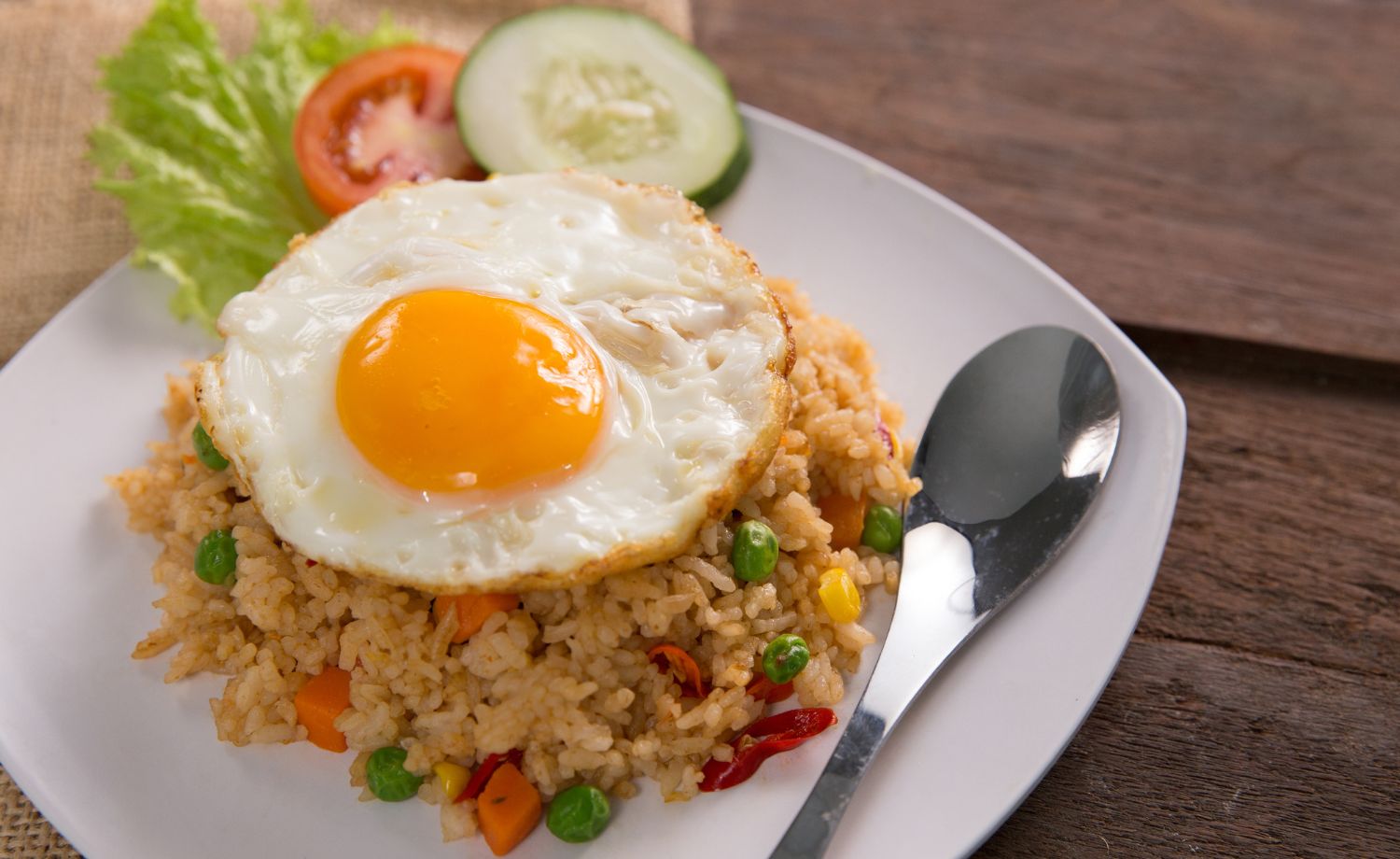
If you are on the lookout for something fast yet tasty for lunch, nasi goreng (fried rice) is high on the list. It has various delicious versions including nasi goreng kampung, nasi goreng tom yam, nasi goreng USA and many more. The fried rice you will find in Malaysia is always packed with plenty of flavour with ingredients on one plate. You can also easily find nasi goreng served in most Malay restaurants nationwide, each of them adding its touch and flair to the dish.
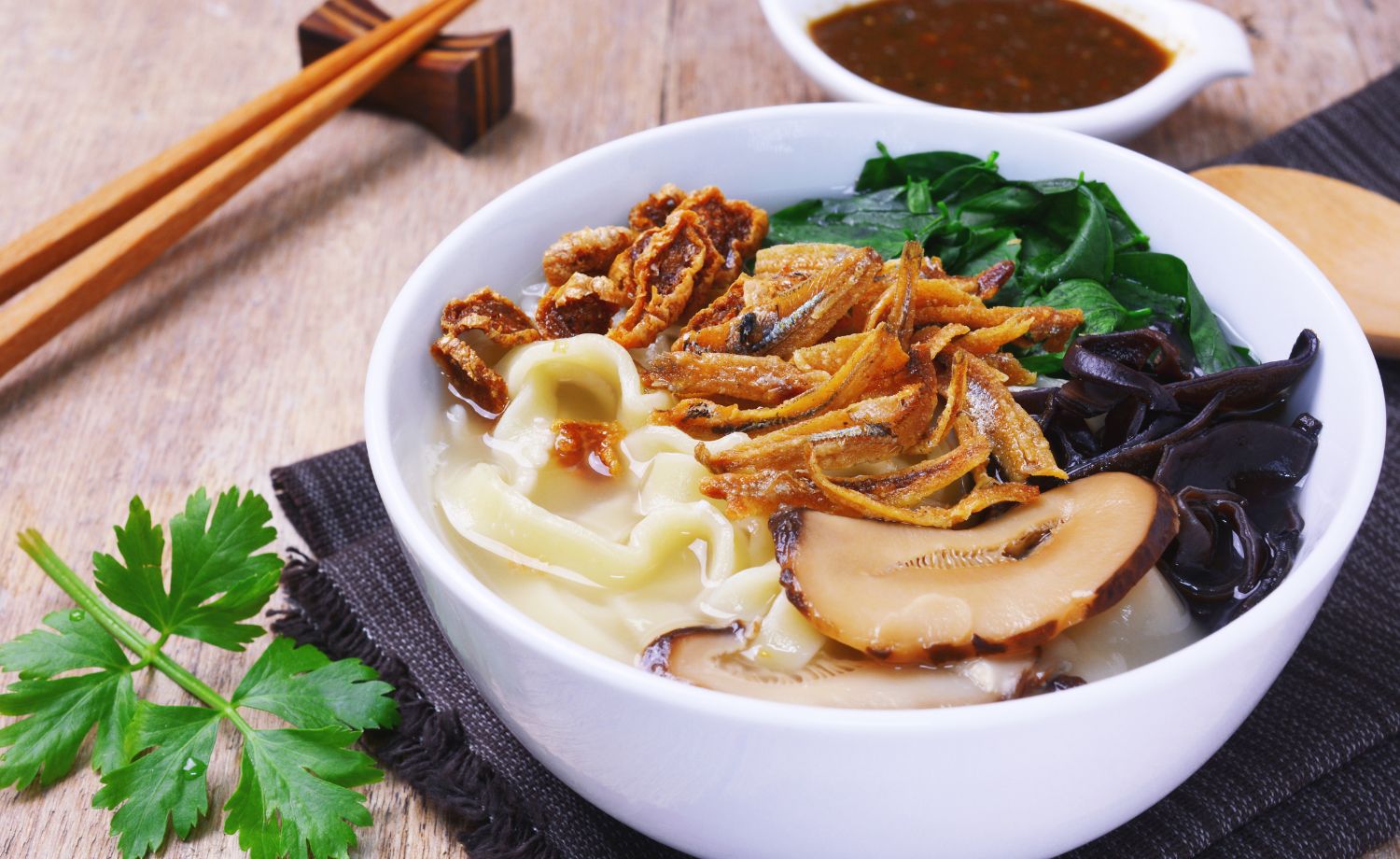
A common Malay or Chinese meal that is often served for lunch is pan mee. This noodle dish is made using thick, flat noodles that come in a clear and savoury broth that is packed with flavour. To finish, it is usually garnished with a sprinkle of minced meat for added protein. Pan mee can also be served ‘dry’, an alternate version where you can enjoy the noodles doused in savoury soy sauce instead of the broth. If you are looking for a halal version of pan mee, keep a lookout for any Malay restaurants in the area that serve this warm and comforting dish.
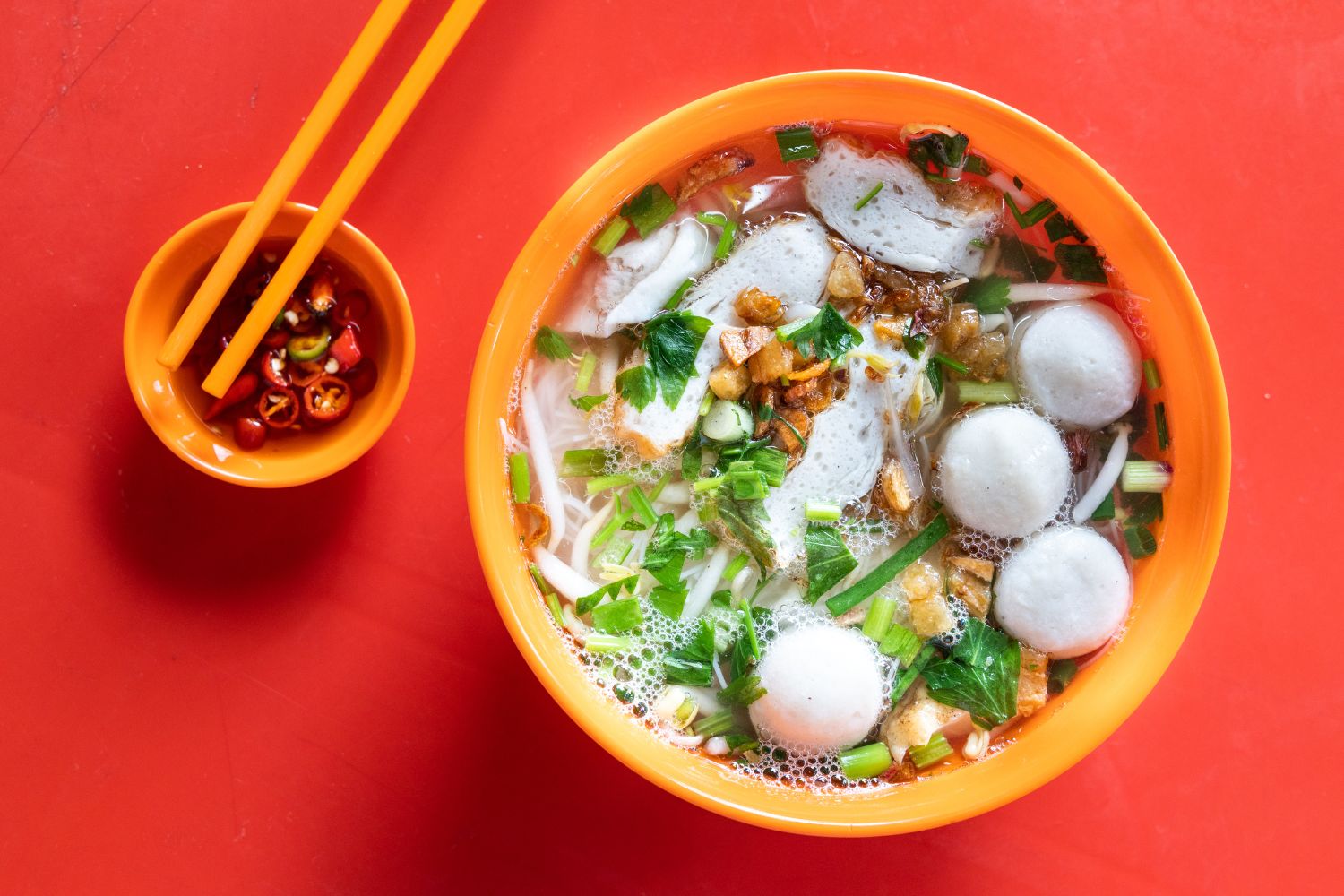
Similar to pan mee, fish ball soup is a common Malay and Chinese delicacy as well. The dish can be enjoyed with or without noodles. Fish ball soup features a clear-based broth that is filled with ‘bouncy’ fish balls or sometimes with fishcakes as well and a sprinkle of chopped green onions for extra flavour. This hearty meal can be found at most Malay or Chinese restaurants.
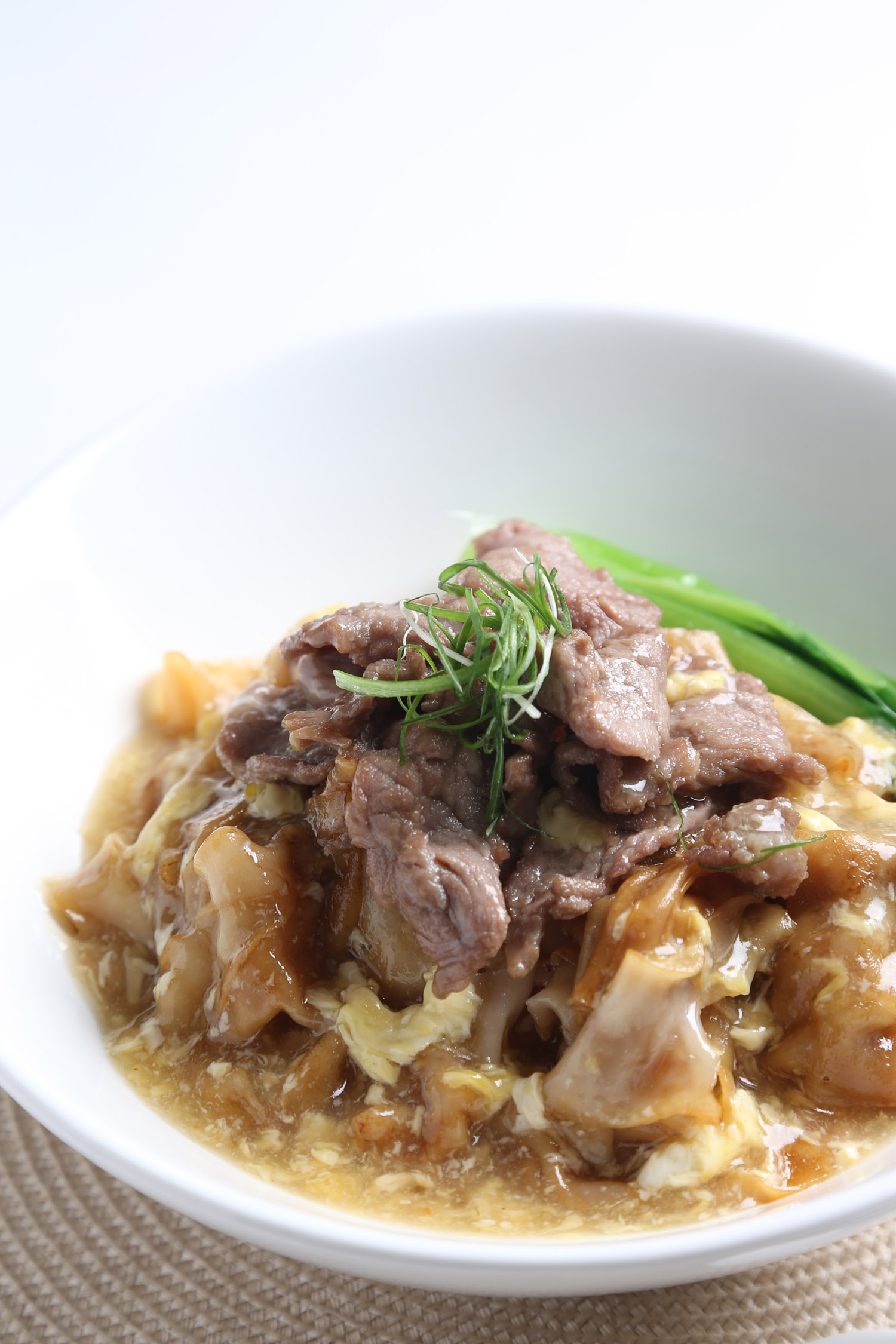
This smoky, charred noodle dish is a definite must-try lunch option, featuring silky-smooth kuey teow tossed with tender beef slices and cooked to perfection in a fiery wok, making it a mouthwatering delight. Very popular among the Malay also Chinese community here in Malaysia, Beef Kuey Teow can be found in most halal and non-halal restaurants.
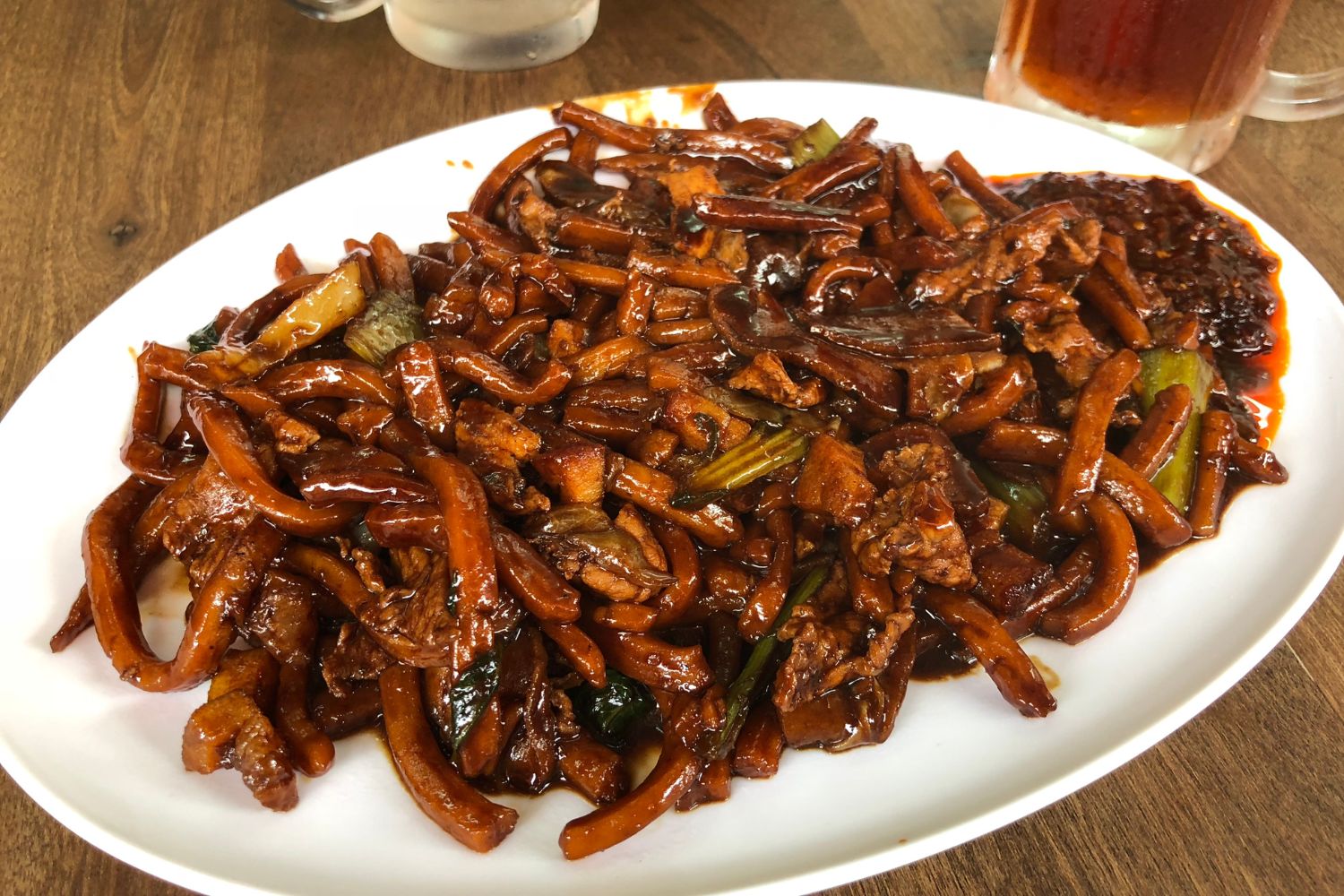
A signature dish served in many Chinese restaurants, Hokkien Mee consists of thick noodles coated in dark soy sauce and tossed with Chinese cabbage, sliced meat and prawns in a wok on high heat for that delicious, charred finish.
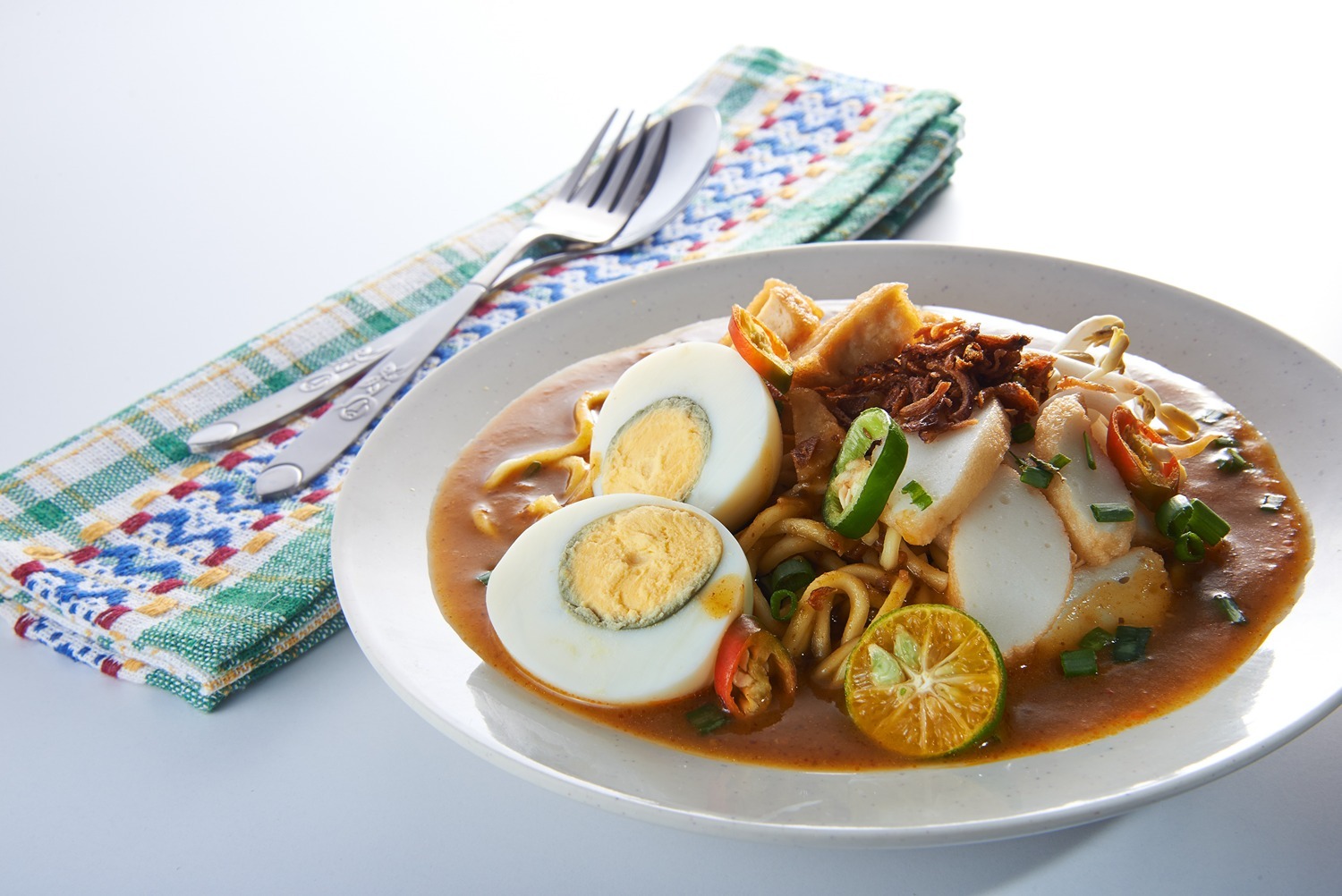
Mee Rebus is a comforting combination of yellow egg noodles drenched in an ambrosial gravy. This thick, spicy-sweet concoction gets its oomph from a potent blend of spices and a peanut-based rempah (spice paste). The noodles are firstly blanched to maintain an al dente bite, then generously smothered in gravy.
Tender beef, crunchy bean sprouts and a slice of lime add layers of flavour also a texture, while a sprinkle of crispy shallots provides the finishing touch. The gravy clings to the noodles delightfully, making each mouthful a tasty balance of slippery smoothness and toothsome bite.
This belly-warming dish traces its origins back to the Malay and Javanese communities. You may find slight regional variations, but the core components remain largely the same. Once you've sampled mee rebus, you will understand why it's a lunchtime go-to for many.
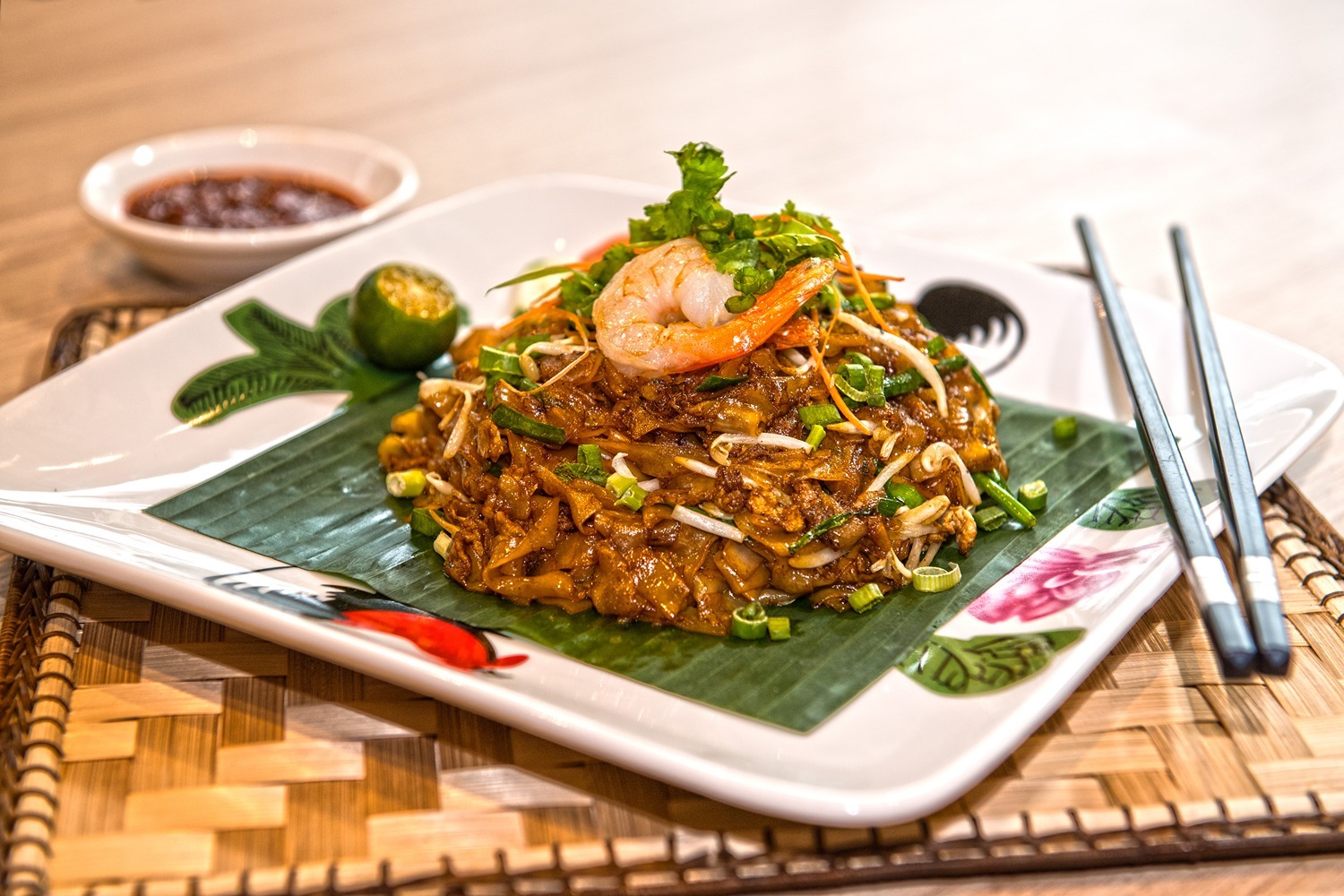
Smoky, savoury and oh-so-satisfying, Char Kuey Teow reigns supreme in the realm of Malaysian hawker cuisine. Juicy prawns, tender cockles, bean sprouts, chives and scrambled eggs come together harmoniously with wide rice noodles in this epic stir-fry.
But the real magic happens in the flaming hot wok, be it the halal or the non-halal version. For the non-halal version, the skilled cook uses lard with shallot oil and also flash-fries the ingredients over blistering heat, imparting an irresistible aroma known as wok hei. Sweet and dark soy sauce caramelises to create a depth of flavour that will leave you dreaming about it for days. Some serious foodies insist on adding a sinful dollop of pork lard for extra oomph. Char Kuey Teow is a non-halal dish that is served in most Chinese restaurants. However, multiple restaurants around the country serve up a halal version of the dish.
Penang folks hotly contend that their version reigns supreme and many flock to the island just to taste the char kuey teow at the lauded Lorong Selamat hawker stall. The owner uses mantis prawns in his rendition, which impart a uniquely sweet flavour. Regardless of where you sample this dish, you will be sure to fall head over heels at first bite.
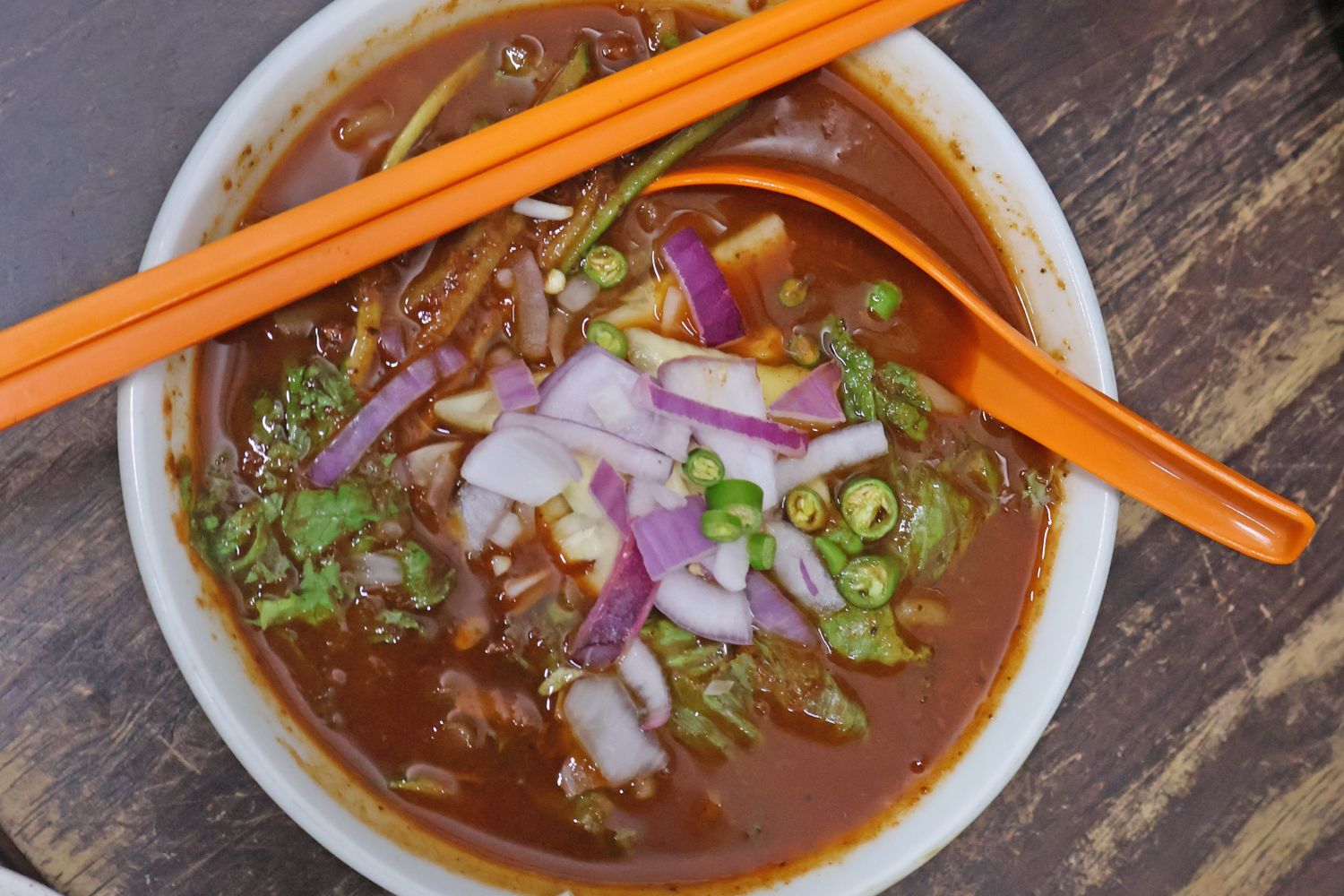
Assam Laksa, the tangy sister of curry laksa, holds a special place in the hearts of many Penangites. This piquant, fish-based soup gets its signature pucker from the tamarind (assam also means tamarind in Malay). This dish features thick rice noodles drowned in a rich broth fragrant with lemongrass, galangal and chillies.
Tender flakes of mackerel, pineapple chunks, sliced onions, cucumber slivers and mint leaves add pops of flavour with freshness to the mix. A dollop of pungent hae ko (a thick, sweet shrimp paste) is the crowning touch. Each spoonful is an explosion of bright, tangy flavours with a potent hit of sweetness from shrimp paste.
Assam laksa consistently tops lists of must-try Malaysian dishes, even earning a spot on CNN's ‘World's 50 Best Foods’ list. It is no surprise that Penang, the undisputed street food capital of Malaysia, dishes some of the finest assam laksa around. Locals swear by the version served at the unassuming Air Itam market - one taste and you very well may be a convert.
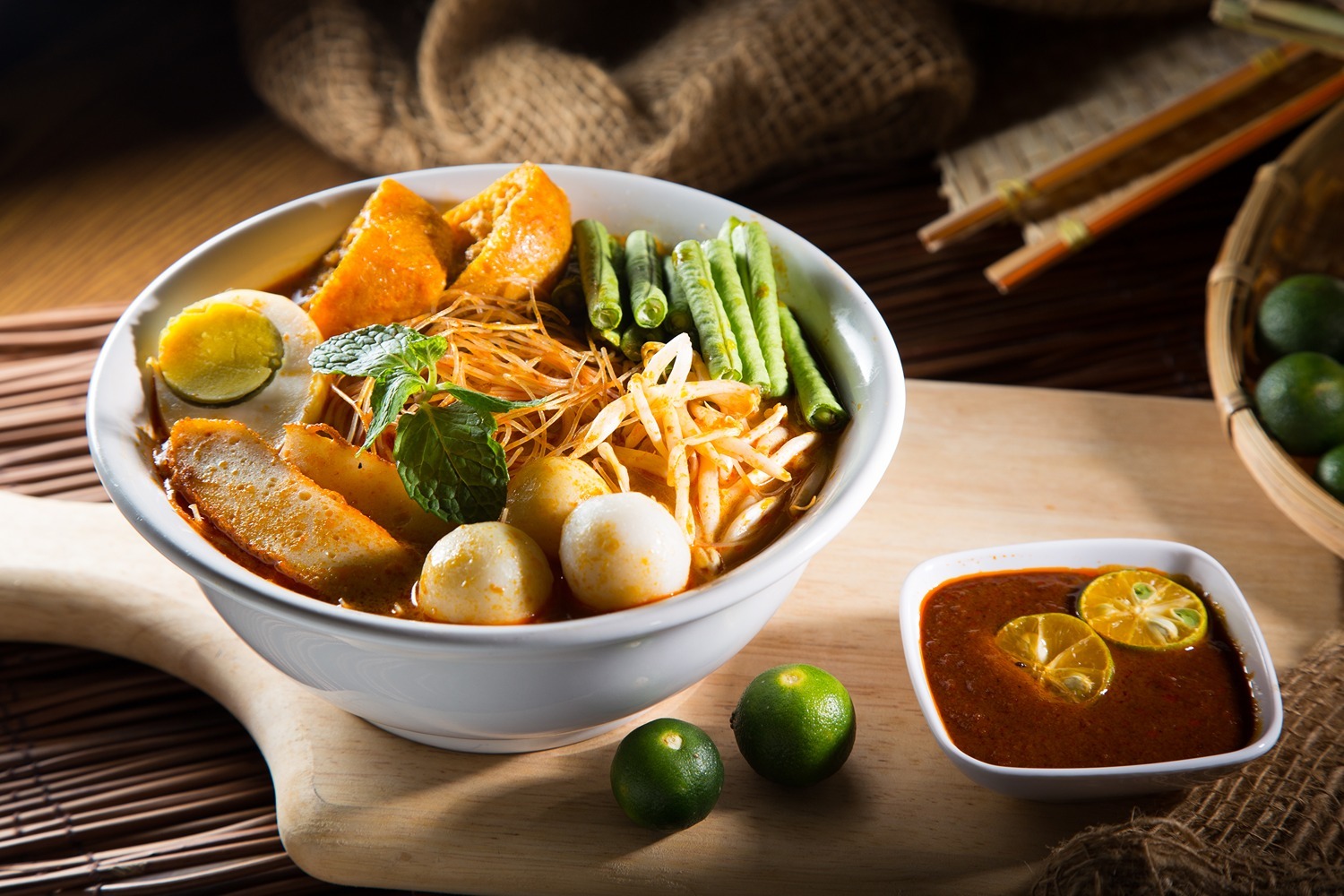
If there were an award for the most luscious Malaysian lunch dish, Curry Laksa would be a top contender. This rich, creamy coconut milk-based soup is fragrant with an aromatic medley of spices like chillies, turmeric, lemongrass and belacan (fermented shrimp paste).
Yellow noodles or rice vermicelli form the base, while plump shrimp, fish balls, cockles, shredded chicken and fried tofu puffs add bursts of flavour. A tangle of crunchy bean sprouts and Vietnamese coriander (daun kesum) lighten things up. A spoonful of sambal (chilli paste) on the side awaits to ramp up the heat.
This dish varies quite a bit from state to state, with each region swearing by their version. The Sarawakian interpretation uses a pungent sambal belacan as the backbone.
Curry laksa is one of the many staples of Malaysian cuisine. During your visit, don’t forget to grab a bowl of this hot and spicy noodle dish to get a taste of Malaysia with every bite.
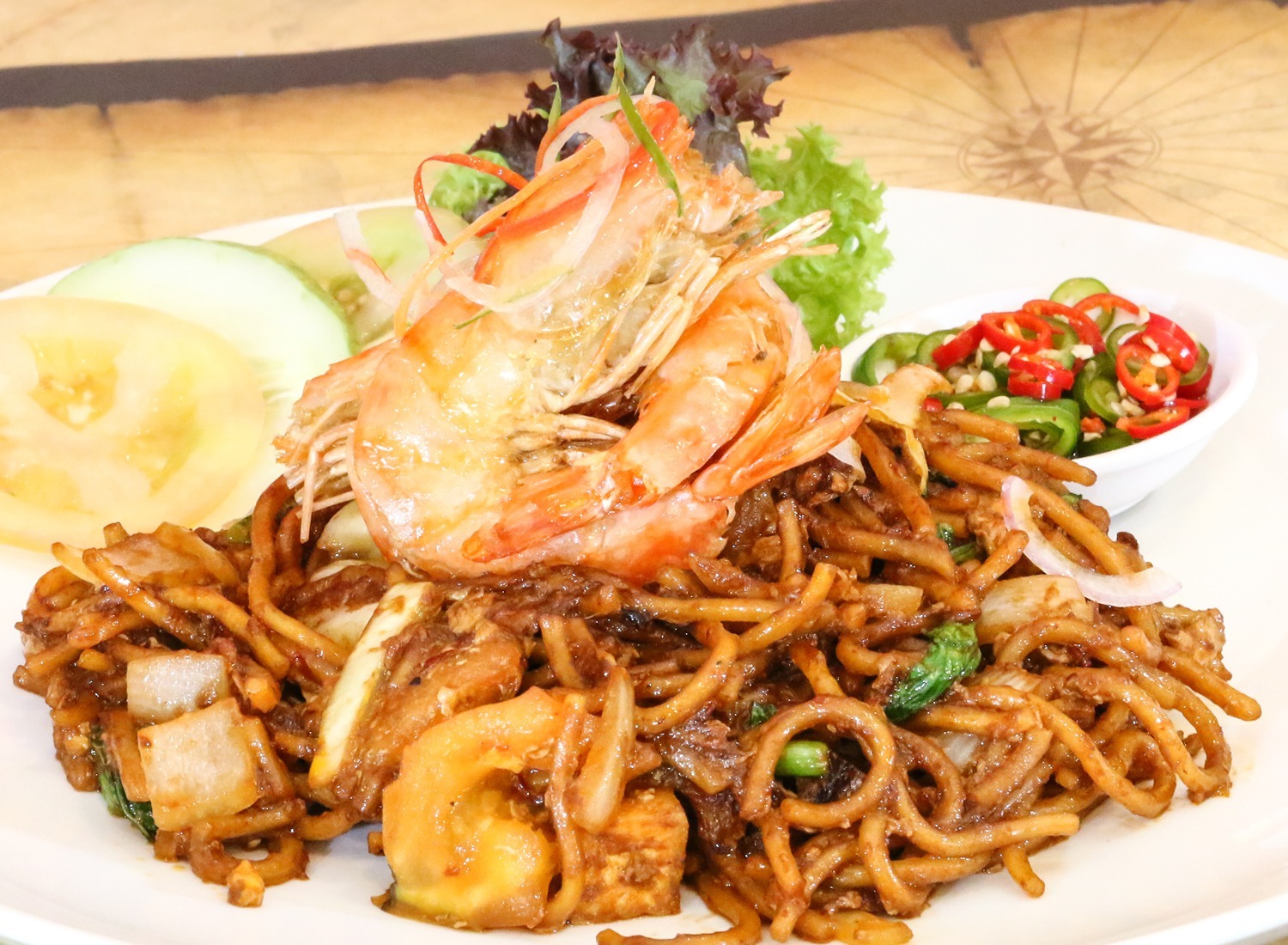
Mee Goreng, literally ‘fried noodles’, may sound unassuming, but this Indian Muslim take on the dish is positively addictive. Yellow noodles are tossed in a scorching hot wok with a sweet-savoury blend of tomato and chilli sauce, potatoes, scallions, bean sprouts also tofu.
The crowning glory is a generous dollop of ‘mee goreng sauce’, a cheeky concoction that usually includes Worcestershire sauce, oyster sauce and ketchup. The sauce caramelises in the wok, coating each noodle with a slick of flavour. A squeeze of lime adds a welcome hit of acidity.
You will find mee goreng mamak (Indian Muslim-style mee goreng) at practically every hawker centre or 24-hour Mamak shop. Some stalls kick things up a notch by adding squid, shrimp or mutton to the mix. It is a classic Malaysian lunch choice for those craving a quick and tasty carb fix.
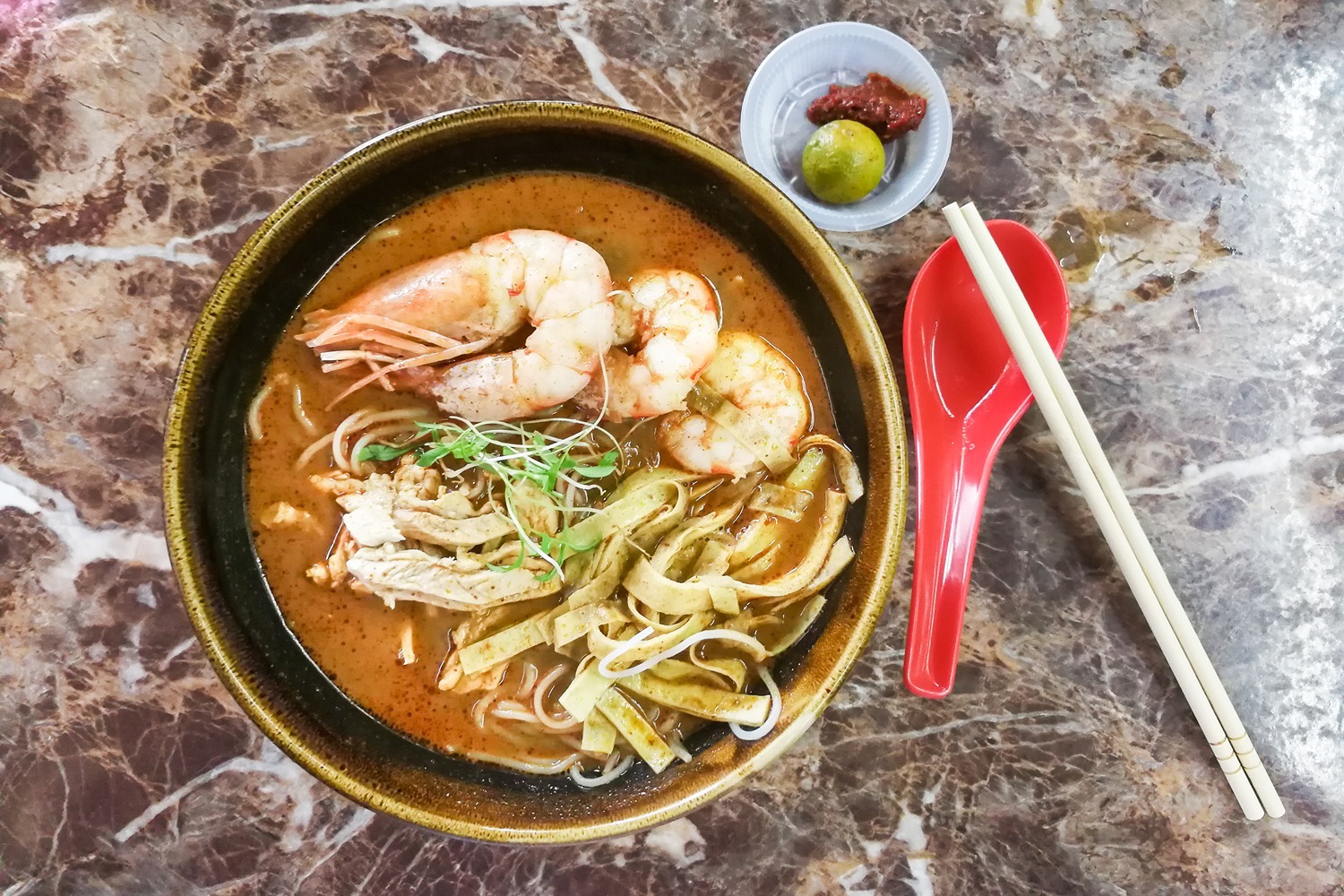
No dish better embodies Sarawak’s vibrant, multicultural spirit than the Laksa named ‘breakfast of the gods’ by the late Antony Bourdain.
The soup's broth is murky, reddish-brown in colour, thickened with flakes of mackerel and tamarind paste. Floating on top are slippery rice noodles, shredded chicken along with egg slices. A generous spoonful of pungent shrimp paste and a scattering of fresh mint leaves complete the dish.
Sarawak’s laksa can be found at hawker stalls and restaurants, each with its subtle variations on the classic recipe. While usually a breakfast item, several stores also offer laksa as a lunch treat as well.

Mee Jawa is a hearty noodle dish that is perfect for a satisfying midday meal. Thick yellow noodles are smothered in a rich, slightly sweet potato-based gravy, then topped with a medley of tender beef, crunchy bean sprouts and half a hard-boiled egg.
The secret to Mee Jawa's irresistible flavour lies in its gravy, which is simmered with rempah, a fragrant spice paste made from lemongrass, galangal, dried chillies and shrimp paste. This complex interplay of sweet, savoury plus spicy notes is what sets Mee Jawa apart from other Malaysian noodle dishes.
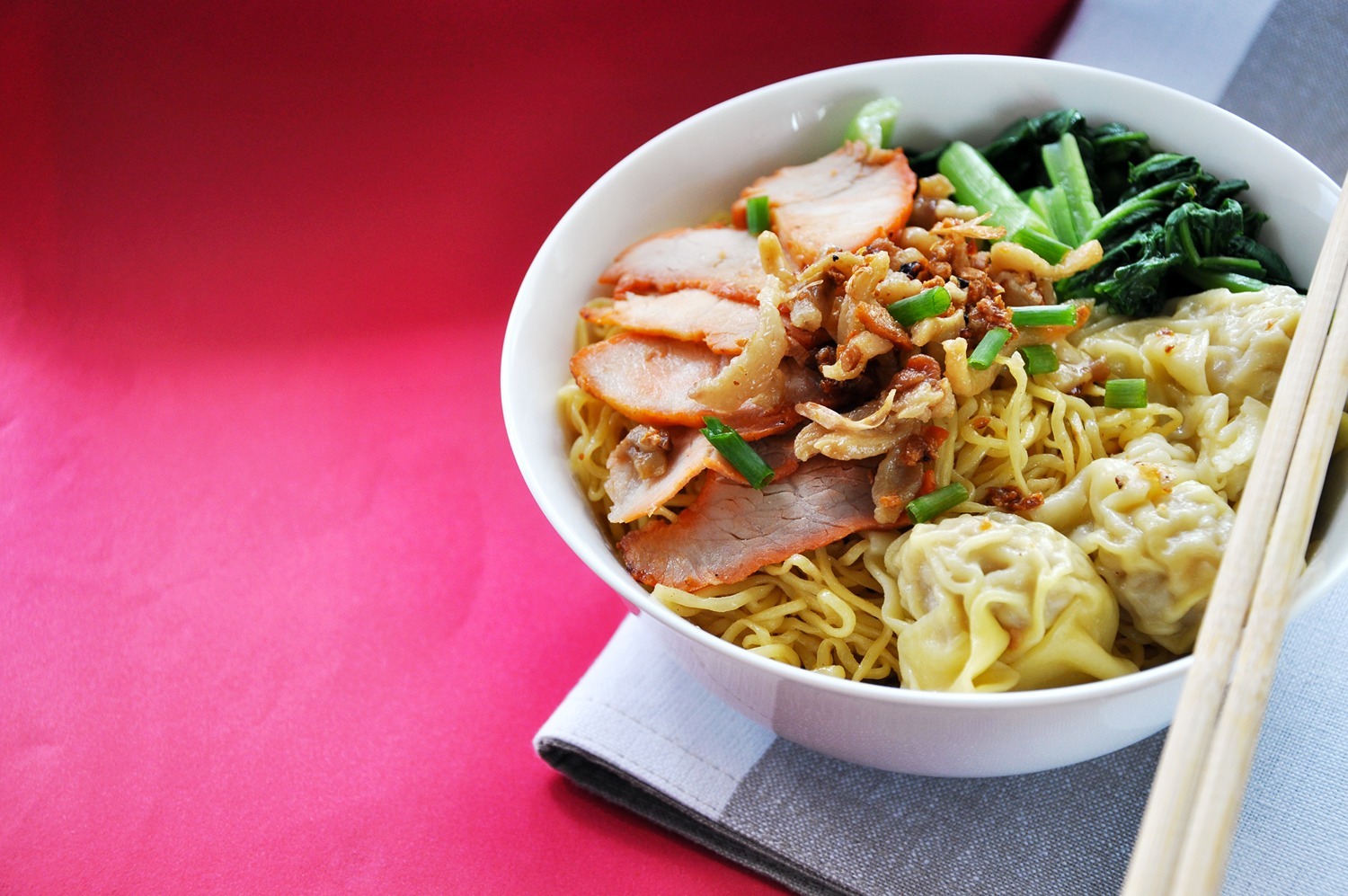
Wantan Mee is a lunchtime favourite across Malaysia. Springy egg noodles are tossed in a savoury sauce, then topped with plump wonton dumplings, tender slices of char siu (barbecued pork) and crisp stalks of choy sum. There are also quite a few restaurants that have made halal versions of this dish for everyone to enjoy. Halal wantan mee features chicken meat instead of the traditional barbecued pork.
What sets Malaysian wantan mee apart is its sauce – a delicious blend of soy sauce, oyster sauce, sesame oil and lard that coats each strand of noodle in umami goodness. Some hawkers add a spoonful of chilli oil to give the dish an extra kick.
While the exact origins of wantan mee are unclear, the dish was likely brought to Malaysia by Cantonese immigrants in the late 19th or early 20th century.
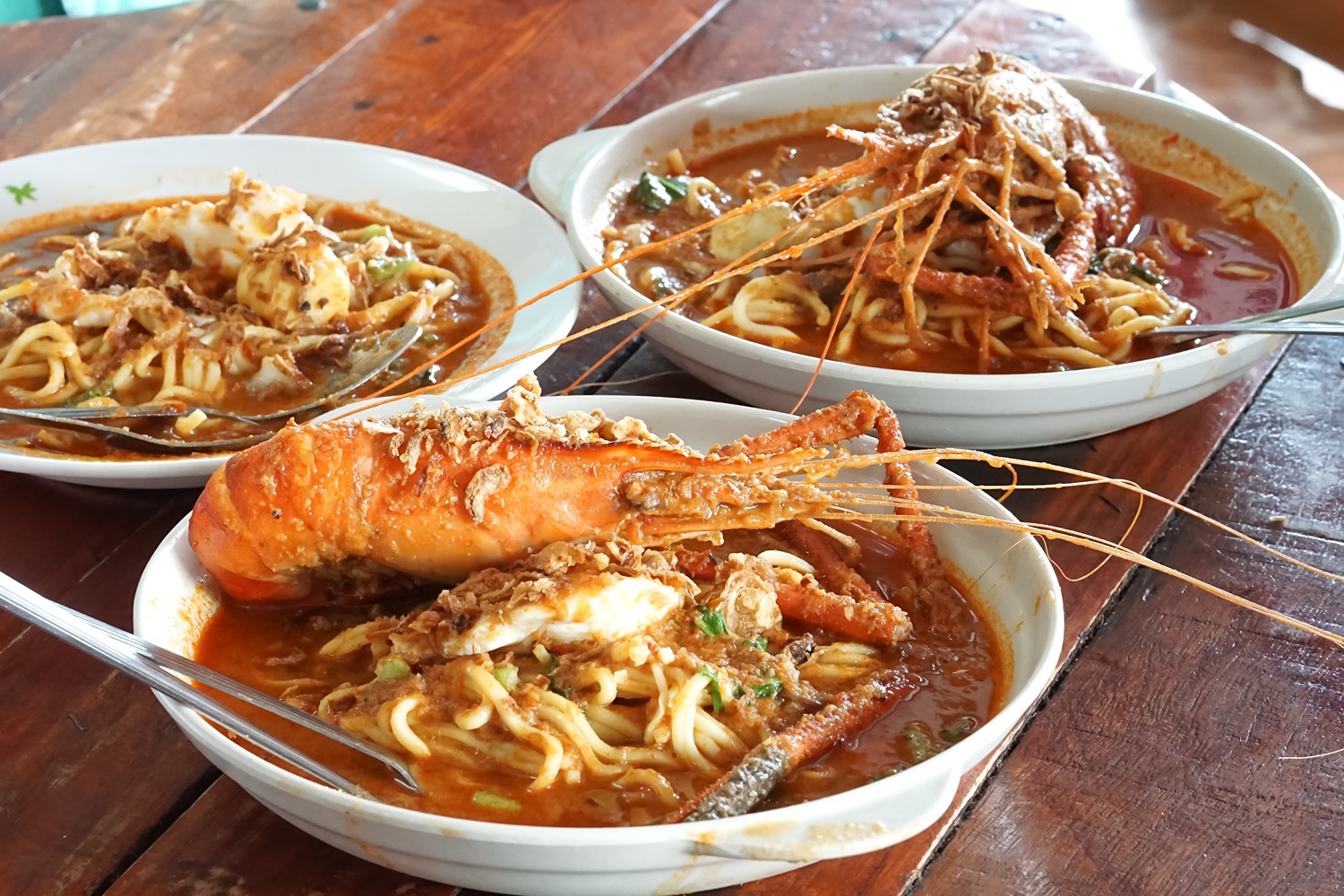
Mee Bandung is a speciality originating from the southern state of Johor and is perfect for anyone who likes lunches with some zing. The spicy, tangy noodle dish is made using thin yellow noodles that are served in a fiery red broth made from dried chillies, tomatoes and tamarind paste, then topped with tender shrimp, hard-boiled egg and crunchy fried shallots.
The key to mee bandung's addictive flavour is the balance between the sourness of the tamarind, the sweetness of the tomatoes and the heat of the chillies. Some hawkers also add a spoonful of creamy sweet potato puree to thicken the broth and provide a welcome contrast to the tanginess.
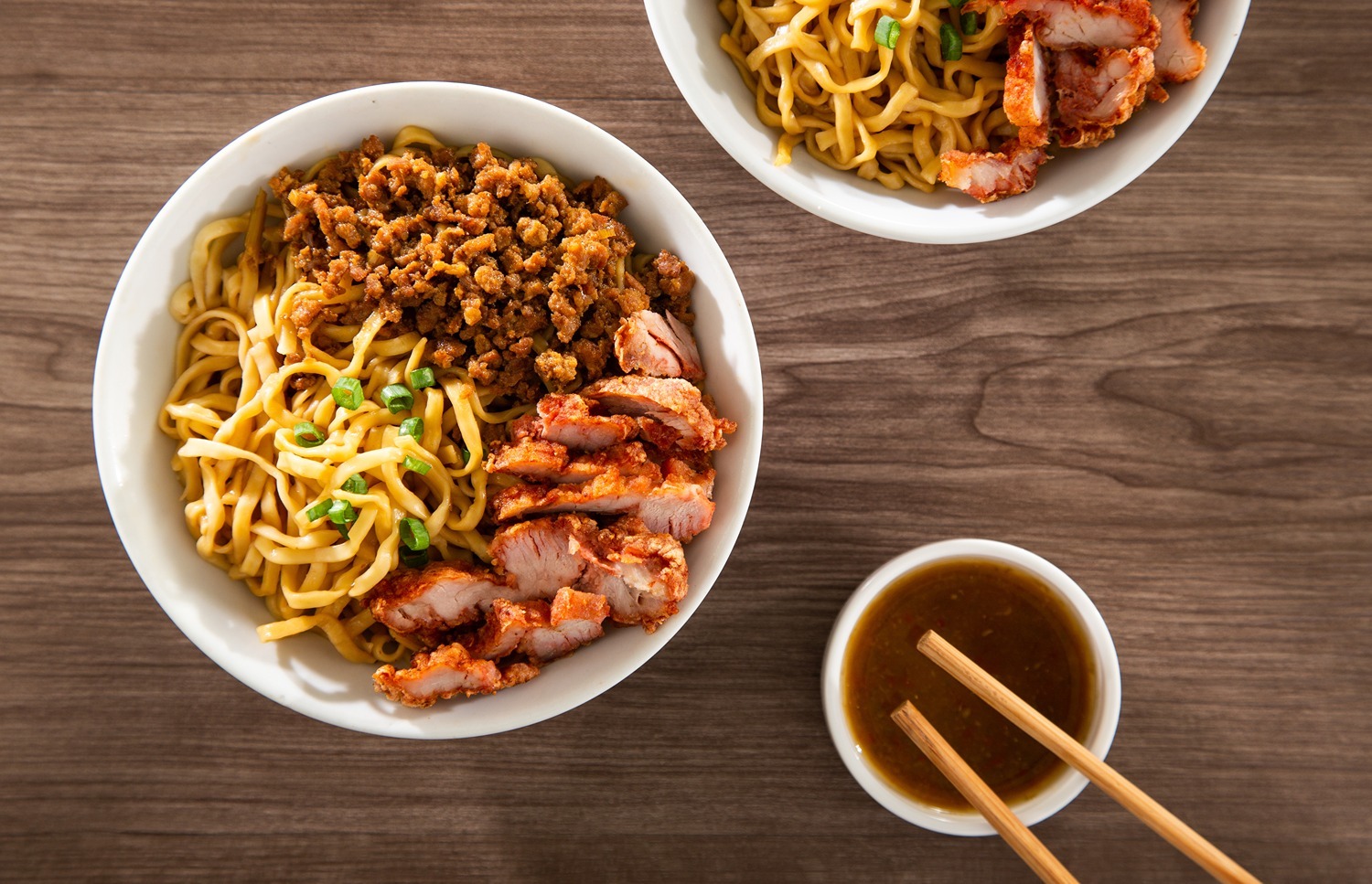
Kolo Mee is a popular noodle dish that hails from the Malaysian state of Sarawak on the island of Borneo. It consists of springy egg noodles that are tossed in a savoury sauce made using soy sauce, vinegar and pork lard, then topped with sliced char siu (barbecued pork), minced pork and sometimes shrimp or fish balls as well. For those seeking a halal version of this dish, rest assured that many restaurants offer excellent Kolo Mee options, substituting pork with halal meats such as beef, chicken as well as duck.
What sets kolo mee apart from other Malaysian noodle dishes is its simplicity yet focus on high-quality ingredients. The noodles are typically made fresh each day and have a slightly chewy texture that is a perfect match for the savoury sauce and tender pork toppings.
Kolo mee is a beloved breakfast also lunchtime dish in Sarawak, where it is often enjoyed at open-air hawker centres or coffee shops.

Kueh Chap is a comforting Teochew-style noodle soup that is a popular breakfast and lunchtime dish in Malaysia. It consists of flat, broad rice noodles served in a savoury broth made from pork and soy sauce, along with an assortment of pork offal, tofu also hard-boiled eggs.
The key to a great kueh chap lies in the quality of the broth, simmered for hours with pork bones, garlic, plus spices until it develops a rich, flavorful, slightly sticky taste. The pork offal, which may include intestines, stomach or liver, is carefully cleaned, simmered until tender, then sliced and added to the soup with the noodles as well as other toppings.
Kueh chap is often enjoyed with a side of braised duck meat, which adds an extra layer of richness and flavour to the dish. It is also typically served with a spicy chilli sauce on the side, which can be added to taste to give the soup an extra kick.
While kueh chap may not be as well-known as some of Malaysia's other noodle dishes, it remains a beloved comfort food enjoyed by many Malaysians, particularly those of Teochew descent. It is a hearty, satisfying meal that's perfect for those days when you need a little extra nourishment and warmth.
As you can see, from the humble hawker fare to elaborate rice meals, there is something to satisfy every craving and budget when it comes to the diversity of Malaysian lunch dishes. The extent of its vibrant flavours with influences on display is a testament to Malaysia's multicultural heritage - a delicious melting pot of Malay, Chinese, Indian and indigenous traditions.
But the real beauty of Malaysian cuisine lies in its accessibility. You do not need to dine at a fancy restaurant or have a degree in culinary arts to appreciate the nuances of a well-made nasi lemak or roti canai. Some of the best meals can be found and enjoyed at a plastic table by the roadside, elbow-to-elbow with locals from all walks of life.
So the next time you find yourself in Malaysia, be sure to leave your preconceptions (and calorie-counting) at the door. Seek out that unassuming stall with the longest queue, pull up a rickety chair and dig in with gusto. You might just discover your new favourite lunch dish in addition to a renewed appreciation for the wonders of Malaysian hospitality.
One word of advice: come hungry. With so many tantalising options to choose from, you may want to save plenty of room for second (or third) helpings. Don't be afraid to venture off the beaten path - some of the most memorable meals are often found in the most unlikely of places.
Above all, approach each dish with an open mind with a sense of adventure. Malaysian cuisine is all about bold flavours, unexpected combinations and a willingness to get your hands dirty, quite literally. Embrace the messiness, the heat, along with the sheer joy of eating - for sure you will be richly rewarded.